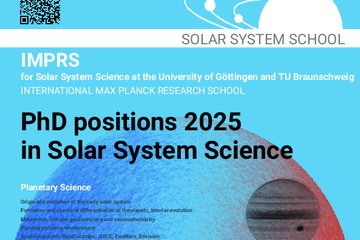All genres
21.
Journal Article
Coordination within the remote sensing payload on the Solar Orbiter mission. Astronomy and Astrophysics 642, A6 (2020)
22.
Journal Article
Detection of the Strongest Magnetic Field in a Sunspot Light Bridge. The Astrophysical Journal 895 (2), 129 (2020)
23.
Journal Article
Connecting the Wilson depression to the magnetic field of sunspots. Astronomy and Astrophysics 635, A202 (2020)
24.
Journal Article
No universal connection between the vertical magnetic field and the umbra-penumbra boundary in sunspots. Astronomy and Astrophysics 639, A106 (2020)
25.
Journal Article
Helicity proxies from linear polarisation of solar active regions. Astronomy and Astrophysics 641, A46 (2020)
26.
Journal Article
The magnetic fine structure of the Sun's polar region as revealed by Sunrise. Astronomy and Astrophysics 644, A86 (2020)
27.
Journal Article
Models and data analysis tools for the Solar Orbiter mission. Astronomy and Astrophysics 642, A2 (2020)
28.
Journal Article
The Polarimetric and Helioseismic Imager on Solar Orbiter. Astronomy and Astrophysics 642, A11 (2020)
29.
Journal Article
PMI: The Photospheric Magnetic Field Imager. Journal of Space Weather and Space Climate 10, 54 (2020)
30.
Journal Article
The Solar Orbiter Science Activity Plan: translating solar and heliospheric physics questions into action. Astronomy and Astrophysics 642, A3 (2020)
31.
Journal Article
A comparison between solar plage and network properties. Astronomy and Astrophysics 630, A86 (2019)
32.
Journal Article
Using the infrared iron lines to probe solar subsurface convection. Astronomy and Astrophysics 630, A133 (2019)
33.
Journal Article
Superstrong photospheric magnetic fields in sunspot penumbrae. Astron. Astrophys.; EDP Sciences, Les Ulis Cedex A France 631, A99 (2019)
34.
Journal Article
SOPHISM: An End-to-end Software Instrument Simulator. The Astrophysical Journal Supplement Series 237 (2), 35 (2018)
35.
Journal Article
Temporal evolution of arch filaments as seen in He I 10 830 Å. Astronomy and Astrophysics 617, A55 (2018)
36.
Journal Article
Measuring the Wilson depression of sunspots using the divergence-free condition of the magnetic field vector. Astronomy and Astrophysics 619, A42 (2018)
37.
Journal Article
Bihelical Spectrum of Solar Magnetic Helicity and Its Evolution. The Astrophysical Journal 863 (2), 182 (2018)
38.
Journal Article
Evershed and Counter-Evershed Flows in Sunspot MHD Simulations. The Astrophysical Journal 852 (2), 66 (2018)
39.
Journal Article
Oscillations on Width and Intensity of Slender Ca ii H Fibrils from Sunrise/SuFI. Astrophysical Journal, Suppl. Ser. 229, 7 (2017)
40.
Journal Article
Morphological Properties of Slender Ca II H Fibrils Observed by Sunrise II. Astrophysical Journal, Suppl. Ser. 229, 6 (2017)











